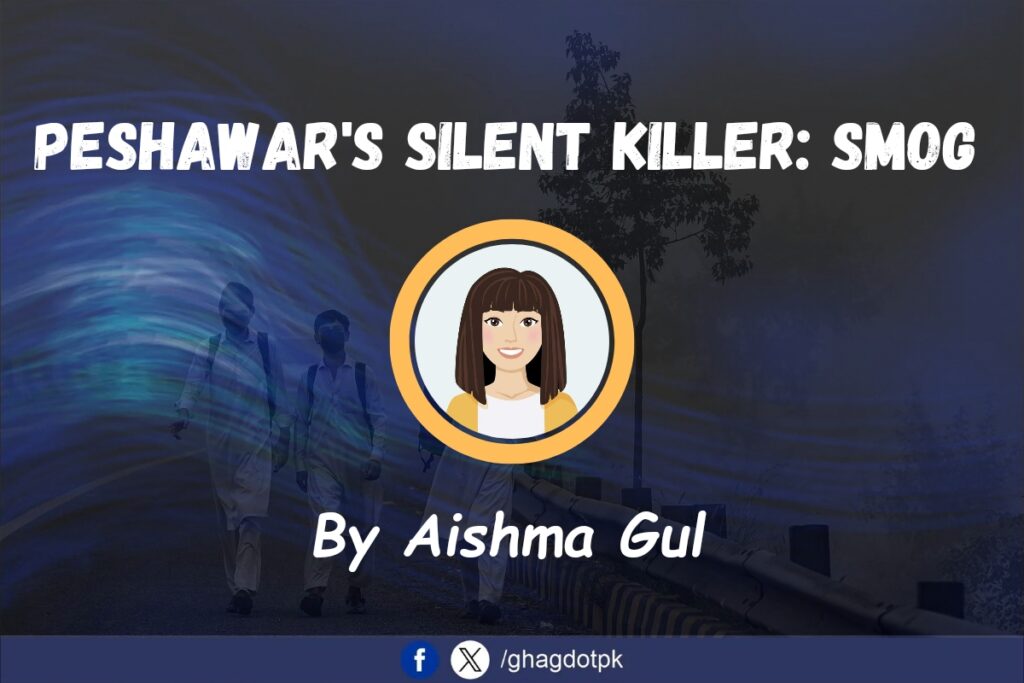By Aishma Gul
“The air we breathe has become a silent killer.”—an expression that resonates all too well in Peshawar, a city that was once known for its abundant greenery and clean air. Peshawar is currently experiencing hazardous amounts of smog, which has turned its skies from clear blue to a dull grey, endangering its citizens’ health, economy, and overall security. It is presently listed as one of Pakistan’s most polluted cities, alongside Lahore and Multan. As the city struggles with thick smog, respiratory problems such as influenza, chest infections, and throat problems have increased, disrupting daily life and creating health concerns. With an Air Quality Index (AQI) of 509, this environmental issue has serious public health consequences.
Understanding Smog and Its Dangers
Smog is a deadly combination of fog and pollution that is often caused by car emissions, industrial waste, and crop burning. It is especially dangerous in the colder months, when pollutants are held close to the ground due to temperature inversions, creating visibility problems and health hazards. The World Health Organisation (WHO) has long cautioned about the health risks associated with smog, including respiratory problems, strokes, and heart disease. Globally, smog costs an estimated seven million lives annually, underscoring its severe public health implications. According to the WHO, 9 out of every 10 people on the planet breathe polluted air, highlighting the widely prevalent and serious consequences of air pollution.
The Situation in Peshawar
Due to a heavy layer of pollution moving in from Punjab, the smog problem in KP, particularly Peshawar, has gotten worse. Uncontrolled two-stroke rickshaws, brick kilns, industry, and domestic fuel consumption are the primary causes of pollution. Residents of Peshawar are fighting to breathe clean air because of this mixture, which has made the city’s air poisonous. Because of the ongoing air pollution, residents report more cases of influenza, throat infections, and chest problems. The Environmental Protection Department reports that although fog has been observed in certain areas due to low humidity, smog is still a major issue in the city’s central regions, with visibility only slightly improving after 11 a.m. The local EPD also observes that although respiratory illnesses are still on the rise, Peshawar’s visibility is still somewhat better than Punjab’s because of fog rather than constant smog.
Health Impacts of Smog
Peshawar’s citizens deal with the smog problem daily. Children, the elderly, and people with previous medical issues are particularly affected by smog’s toxic chemicals, which include sulphur dioxide, nitrogen dioxide, and particle matter. These pollutants cause respiratory problems, cardiovascular diseases, and cognitive impairments. The World Bank reported that air pollution in Pakistan causes approximately 135,000 premature deaths each year.
Economic Impact
Smog’s effects on the economy are just as serious. According to World Bank estimates, the annual cost of air pollution to the world economy is approximately $5 trillion. Public funds that could be used to fund infrastructure and social services are being drained by the rising costs of healthcare brought on by illnesses linked to air pollution. Industries and trade may be impacted by traffic disruptions brought on by decreased visibility. Furthermore, the travel industry, which is based on the city’s natural beauty, is at risk by the poor air quality. Pakistan’s economic resilience is further weakened by smog’s effects on crop productivity, which affects food security and economic stability. Based on World Bank estimates, air pollution lowers Pakistan’s GDP by 2-3% every year, which has a direct impact on the nation’s development objectives and economic potential. Additionally, smog damages buildings and bridges, demanding more frequent repairs and adding to the financial load.
Smog and Security: A Complex Relationship
The relationship between pollution and security is complex. Smog causes environmental damage, resulting in resource scarcity, climate change, and natural calamities. It threatens human security by affecting health, social stability, and migration. According to the World Bank, climate change might relocate up to 143 million people by 2050, putting further demand on available resources. Climate change is already threatening Pakistan’s water resources, causing shortages and resource availability. Furthermore, the economic and social implications of smog can destabilize countries and intensify pre-existing security concerns. Smog and pollution also pose ethical concerns since they violate citizens’ fundamental rights to life and health under Pakistan’s Constitution (Article 9), providing serious legal and moral challenges.
Government and Security Forces Response
To control emissions, the Pakistani government has taken steps such as encouraging mask use, prohibiting agricultural waste burning, and limiting high-emission vehicles, but much more work remains to be done. Anti-pollution laws are enforced by security forces, which are often the first responders to national emergencies. The National Highways and Motorway Police recently issued advice urging individuals to drive cautiously or avoid unnecessary travel on foggy days. Roadblocks and diversions are used to avoid accidents caused by reduced visibility. To avoid accidents, the National Highways and Motorway Police recently blocked sections of the M-1 and M-2 highways.
Lessons from Global Smog Crises
Similar problems with air pollution have affected other nations for a long time. For instance, record-breaking pollution levels during China’s 2013 “Airpocalypse” caused severe respiratory diseases as well as financial losses. After implementing strict laws, investing in public transportation, and encouraging renewable energy, China was able to lower its AQI in its largest cities. Pakistan may learn from these lessons, highlighting the necessity of diverse measures that include cleaner fuels and stronger pollution regulations.
The Way Forward
To reduce the consequences of pollution, an extensive approach is required. This involves stronger laws, the promotion of sustainable energy, investments in public transit, international cooperation, and public awareness and education. Stricter emission standards, efficient enforcement, and frequent monitoring are critical. Promoting renewable energy sources such as solar and wind power, as well as installing energy-saving technologies, can help to greatly decrease emissions. Enacting environmentally friendly policies, such as emission limits and eco-taxes, will be critical in reducing pollution levels. Investing in public transport and sustainable urban planning can help minimize dependency on private vehicles. International cooperation is required to solve transboundary air pollution. Public awareness campaigns and educational activities can help people make educated decisions and contribute to a cleaner environment.
Only through collective efforts can Pakistan hope to protect its citizens and preserve the beauty of Peshawar as the “City of Flowers” once more.






